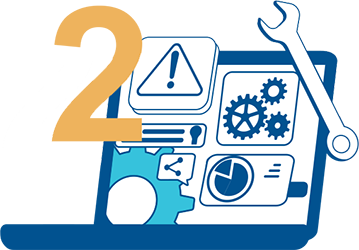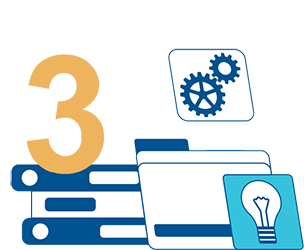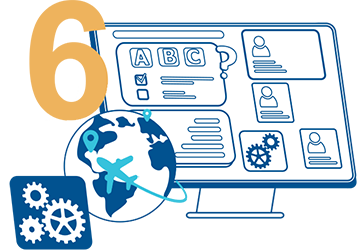FROM DATA STREAMS TO STRATEGIC VALUE
Most SME factories already generate large amounts of data from machines, spreadsheets, or your team’s daily reports. However, this data is often fragmented, difficult to access in isolated machines, spreadsheets or legacy systems, and often fails to support decision-making. This prevents SMEs from using their data to make informed decisions and improve production efficiency. Through the integration and connection of digital technologies and systems, manufacturers are transforming how they operate and make decisions.
Before digitalisation solutions such as AI and digital twins can support in this transformation, the data that is available must be connected, contextualised and made usable across the organisation. Digitalisation solutions require accessible, reliable and structured input to be effective. The first step is what industry often calls “horizontal and vertical integration”, connecting machines, sensors, enterprise systems, and human operators into a coherent digital environment.
The greatest value emerges not simply from integrating and exchanging data, but from generating actionable insights. This shift from basic connectivity to production intelligence is key for SMEs striving to remain competitive in a fast-changing landscape.
Having actionable insight into the shopfloor can help SMEs move from passive data collection and reactive problem solving to active insight generation and proactive decision-making. For example, AI algorithms can detect patterns in production lines that even seasoned engineers may overlook. These insights, when integrated with information from the shopfloor and its environment, enable quicker and more informed decision-making such as adjusting maintenance schedules and redesigning workflows.
Achieving this transformation requires more than just implementing new technology. It involves governance, alignment between IT and operations, and a leadership mindset that treats data not as a by-product but as a driver of business performance.
Digital Twinning: The Smart Core of Information-Driven Manufacturing
Once systems are integrated and data is accessible, digital twinning provides the next leap. A digital twin is a virtual replica of a physical asset, process, or system. But its true power lies in how it learns and evolves using data, creating a dynamic environment for analysis, simulation, and prediction.
Recent research, published in Journal of Manufacturing Systems, outlines a structured digital twinning approach tailored for manufacturing SMEs . The key insight: SMEs do not need massive investment or fully autonomous systems to benefit. Instead, they need solutions that deliver the right information, when it matters most, and deliver only the information that is relevant.
The development of a digital twin of a critical production process, for example, allows SMEs to test out new batch configurations, predict maintenance needs, or simulate the impact of planning changes, all without disrupting the actual operations. By combining live data, models, and domain expertise, such a solution can empower SMEs to make complex decisions faster and with greater confidence.
Successful implementation depends on three things. First, data must be accessible and reliable. Second, the system should be developed around the needs of the people using it. Third, progress should be made in small, manageable steps that deliver value early and often.
Practical Lessons and Next Steps for SME Leaders
Digital transformation is not purely a technical project, it’s a business transformation. Based on both industry cases and our applied research, here are some lessons learned for decision-makers:

Start with a clear vision of how digitalisation will improve your business. The goal is not to adopt AI or automation for its own sake, but to solve specific challenges.

Start with a business problem, not a technology solution. Whether it’s reducing scrap rates, shortening lead times, or increasing throughput, tie your technological investments directly to the needs and goals of the organisation.

Build the capability, not just the system. Investing in people, whether through training, partnerships with universities, or hiring data-savvy engineers, is essential. The best results come when technology complements human expertise rather than replacing it.

Iterate fast, but with structure. Pilot projects with clear boundaries (e.g., one machine, one KPI, one product line) allow teams to learn and adjust quickly.

Encourage cross-functional collaboration. IT, operations, and management need to align on objectives and responsibilities. Make sure that the departments and employees that use the systems and solutions become responsible for its development and implementation.

Don’t do it alone. From regional innovation hubs to European research consortia, there is strong momentum to support SMEs on this journey. Leveraging external expertise can accelerate progress without overstretching internal resources. Don’t hesitate to visit other companies and share experiences about how current technology can be implemented, there are many valuable lessons about digitalisation that companies are more than willing to share if you ask.
Production Intelligence as a Strategic Enabler
In today’s competitive landscape, data is not just a technical resource. It is a strategic asset. SMEs that use their data wisely can improve flexibility, strengthen decision-making, and build more resilient operations. The goal is not to match the capabilities of the largest manufacturers. Instead, SMEs should adopt the technologies that fit their needs and scale.
Digitalisation solutions are not the end goal. Better planning, fewer delays, and more resilient operations are. SMEs that act now and begin turning data into meaningful insights will outperform those who wait.
